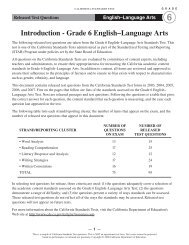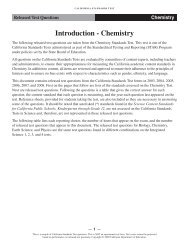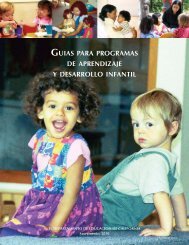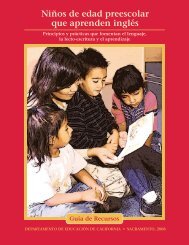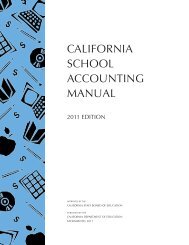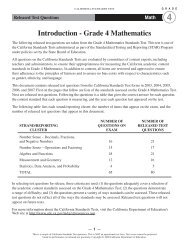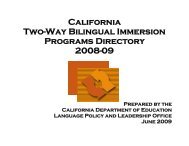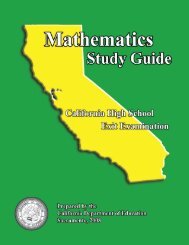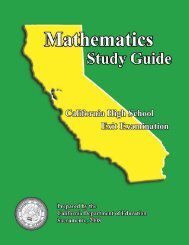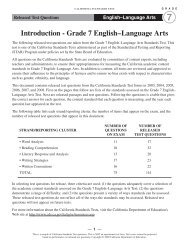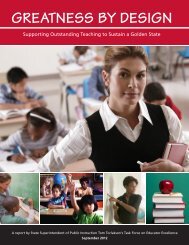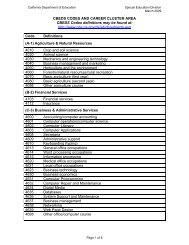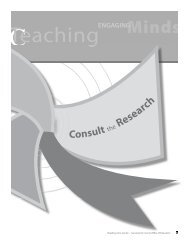Grade 2 - California Department of Education
Grade 2 - California Department of Education
Grade 2 - California Department of Education
You also want an ePaper? Increase the reach of your titles
YUMPU automatically turns print PDFs into web optimized ePapers that Google loves.
State Board <strong>of</strong> <strong>Education</strong>-Adopted <strong>Grade</strong> Two Page 5 <strong>of</strong> 45<br />
MP.4. Model with<br />
mathematics.<br />
reasoning and strategies.<br />
In early grades, students experiment with representing problem situations in multiple<br />
ways including writing numbers, using words (mathematical language), drawing pictures,<br />
using objects, acting out, making a chart or list, creating equations. Students need<br />
opportunities to connect the different representations and explain the connections.<br />
Students model real-life mathematical situations with an equation and check to make<br />
sure that their equation accurately matches the problem context. They use concrete<br />
manipulative and/or math drawings to explain the equation. They create an appropriate<br />
problem situation from an equation. For example, students create a story problem for<br />
the equation 43 + □ = 82 such as “There were 43 gumballs in the machine. Tom poured<br />
in some more gumballs. There are 82 gumballs in the machine now. How many did<br />
Tom pour in?” Students should be encouraged to answer questions, such as “What<br />
math drawing or diagram could you make and label to represent the problem?” or “What<br />
are some ways to represent the quantities?”<br />
MP.5. Use appropriate<br />
tools strategically.<br />
In second grade, students consider the available tools (including estimation) when<br />
solving a mathematical problem and decide when certain tools might be better suited<br />
than others. For instance, second graders may decide to solve a problem by making a<br />
math drawing rather than writing an equation.<br />
Students may use tools such as snap cubes, place value (base ten) blocks, hundreds<br />
number boards, number lines, rulers, virtual manipulatives, diagrams, and concrete<br />
geometric shapes (e.g., pattern blocks, three-dimensional solids). Students understand<br />
which tools are the most appropriate to use. For example, while measuring the length <strong>of</strong><br />
the hallway, students can explain why a yardstick is more appropriate to use than a<br />
ruler. Students should be included to answer questions such as, “Why was it helpful to<br />
use…?”<br />
MP.6. Attend to<br />
precision.<br />
As children begin to develop their mathematical communication skills, they try to use<br />
clear and precise language in their discussions with others and when they explain their<br />
own reasoning.<br />
Students communicate clearly, using grade-level appropriate vocabulary accurately and<br />
precise explanations and reasoning to explain their process and solutions. For example,<br />
when measuring an object, students carefully line up the tool correctly to get an accurate<br />
measurement. During tasks involving number sense, students consider if their answer is<br />
reasonable and check their work to ensure the accuracy <strong>of</strong> solutions.<br />
MP.7. Look for and<br />
make use <strong>of</strong><br />
structure.<br />
Second graders look for patterns and structures in the number system. For example,<br />
students notice number patterns within the tens place as they connect counting by 10s<br />
to corresponding numbers on a 100s chart. Students see structure in the base-ten<br />
number system as they understand that 10 ones equal a ten, and 10 tens equal a<br />
hundred. Teachers might ask, “What do you notice when…?” or “How do you know if<br />
something is a pattern?”<br />
Students adopt mental math strategies based on patterns (making ten, fact families,<br />
doubles). They use structure to understand subtraction as an unknown addend problem<br />
(e.g., 50 – 33 = __ can be written as 33 + __ = 50 and can be thought <strong>of</strong> as “How much<br />
more do I need to add to 33 to get to 50?”).<br />
MP.8. Look for and<br />
express regularity in<br />
repeated reasoning.<br />
Second grade students notice repetitive actions in counting and computation (e.g.,<br />
number patterns to count by tens or hundreds). Students continually check for the<br />
reasonableness <strong>of</strong> their solutions during and after completing a task by asking<br />
themselves, “Does this make sense?” Students should be encouraged to answer<br />
The Mathematics Framework was adopted by the <strong>California</strong> State Board <strong>of</strong> <strong>Education</strong> on November 6,<br />
2013. The Mathematics Framework has not been edited for publication.



